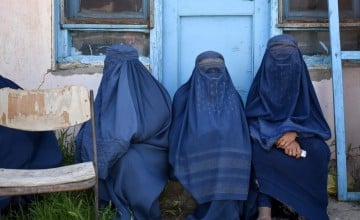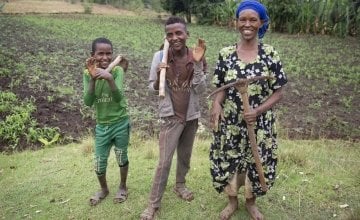
Read our 2023 annual report

Knowledge Hub
One of the major concerns since the beginning of the current pandemic was the disproportionate impact of COVID-19 on women and girls.
While early data showed that men faced a higher mortality risk due to the virus, women were more likely to face a greater social and economic burden. Before 2019, women already faced significant barriers to gender equality, especially around finances, employment, education, unpaid labour, and gender-based violence. COVID-19 only served to deepen those divides.
“COVID-19 could reverse the limited but important progress that has been made on gender equality and women’s rights.”
In 2020, we published an article on this website outlining seven ways that COVID-19 could hit especially hard for women. Unfortunately, many of those predictions came to pass. Concern Worldwide has published one of several studies that has emerged since then about the impact of COVID-19 on women and girls, surveying over 13,800 people in 23 countries. Here are ten ways that the pandemic has had a gendered impact, especially in the world’s most vulnerable communities.
1. Emergencies deepen inequalities that are already there
Call it a pre-existing condition: In communities where inequalities already exist, an emergency can help to widen that gap. This is especially true for gender inequalities. In a country like Afghanistan or South Sudan, where women lack basic rights like financial independence or are more likely to experience domestic violence, an increase in inequality between genders can undo years of progress.

2. Women have lost more income than men due to COVID-19
In low-income countries, 70% of women earn their money through informal labour, such as domestic work and agriculture work that relies heavily on interaction with others. These jobs are less likely to provide paid sick leave or protect workers against job loss or unemployment. The majority of women and men surveyed by Concern told us that their ability to earn an income has declined due to COVID-related shutdowns and social distancing. However, this situation was far worse for women.
Nearly 47% of women surveyed by Concern reported that the financial situation in their home had become a lot worse in the first six months of COVID, compared to just over 40% of men. Another study (not conducted by Concern) interviewed 10,000 women across 38 countries and found that 55% of these women lost jobs or income due to the pandemic, compared to just 34% of men. Even women in the formal job sector have faced inequality due to COVID-19: Women in Bangladesh have been six times more likely than men to lose paid working hours.
3. Women are more likely to go hungry due to the pandemic
The links between the pandemic and increased hunger levels are undeniable. The impact of COVID-19 on women is especially hard in this area, as well. Nearly 48% of women surveyed by Concern said that their families were eating less; compared to just under 36% of men who said the same.
A lot of this comes down to deep-seated gender inequalities. In the communities where Concern works, women are more likely to be responsible for buying and preparing food for their families. As caregivers, they’re also less likely to eat as much as men. Often, women eat last and less than their family members.
“Now I have to feed my children without eating,” one respondent in Bangladesh told us. Another woman, also in Bangladesh, added that she doesn’t share her family’s food struggles with her husband, father-in-law, or children: “My husband sometimes eats a little less when he understands there is less food. I eat after feeding everyone in the family.”

4. Most frontline health workers are female - but they don't always have a voice
According to the UNFPA, nearly 3/4 of the global health and social sector is female, including frontline healthcare within communities. This obviously increases the risk of more women contracting COVID-19, especially since much of the PPE equipment delivered to communities is sized for men.
But the risk for infection is just the tip of the iceberg. As we’ve seen at home and abroad, the emotional needs of healthcare workers (especially those on the frontlines) are more important than ever in a pandemic. Women especially need to be given a seat at the table when it comes to response planning and decision-making. Even with 75% of those working in the health and social sector being female, those who are working on the frontlines and noticing trends or warning signs may go ignored in their community if gender inequality is the norm.
5. In a pandemic, women and girls are most likely to take on the extra labour
Even if you aren’t a healthcare worker, caring for the sick – whether it’s in your own family or at a community level – is a job that generally falls to women. Across the globe, the majority of household and caring responsibilities typically fall to women. This has always impacted women: Before the pandemic, 42% of women of working age said they were unable to do paid work because of their unpaid care and domestic responsibilities. The number of men who said the same was just 6%.
While men are contributing more to unpaid domestic chores than they did prior to COVID, women still take on the majority. One Oxfam survey reported that between 44% and 55% of women are now spending more time on unpaid care and domestic work as a result of COVID-19 and containment measures.
For one man in Mangochi, Malawi, such changes in circumstances were not a reason to change rigid gender norms. “I am the head of this household and that will not change,” he told Concern. “Women do what they are supposed to do and boys also do what they are supposed to do.”
6. Women are facing more mental and physical health challenges due to COVID-19
The increase in unpaid labour at home has negatively impacted women’s economic security, as well as their mental and physical health and wellbeing. 43% of women surveyed by Concern reported feeling more anxious, depressed, overworked, isolated, or physically ill because of this increased workload. In Nairobi’s informal settlements, 26% of women surveyed said that they had been physically unwell, unable to get enough rest, or were feeling stressed and anxious because of increased care responsibilities.
7. A higher male mortality rate also affects women
Men may face a higher mortality rate for COVID-19. However, this doesn’t mean that women who survive the coronavirus have an easier future ahead of them. In fact, a higher male mortality rate means a potential increase in female-headed households, which in some countries means severe socio-economic implications. Female-headed households can be more vulnerable to harassment and violence, especially for displaced families. Losing a patriarch can, in especially vulnerable communities, also cut a family off from regular income and increase the likelihood and severity of poverty.
8. COVID-19 has led to increases in gender-based violence
The financial, social and health stressors of a pandemic, combined with close confinement during lockdowns, mean that women and girls are at a higher risk of violence from their family members, domestic partners, or within a community. We saw this happen during the 2014–2016 Ebola epidemic in West Africa, with increased incidences of gender-based violence, and fewer resources for women and girls who were experiencing abuse (given the increased demand for healthcare workers in helping to halt the spread of the virus).
“The tension between husband and wife has increased more than before. Now the husbands cannot pay for their families properly, cannot meet the needs of the family. With all these, strife is being created in families.”
In July 2020, violence against women and girls was described as a “shadow pandemic” by the UN Secretary General as reports of GBV skyrocketed globally. The Center for Global Development found that of the 30 studies reviewed, 43% showed increases in violence against women and children, and 27% showed mixed findings (which indicates increases in at least one measure of violence and is largely attributed to underreporting).
9. A pandemic can end a girl's education
In many of the countries where Concern works, being a girl is already a barrier to education. When the barrier is amplified by a health crisis and a potential lockdown, this makes maintaining an education difficult for all children, but especially so for girls. Estimates for 2020 suggest that child marriages increased by 500,000, due largely to lockdowns and young girls being married off as a financial remedy. In Sierra Leone, teenage pregnancy was more frequently raised by female respondents than their male counterparts (who, even when probed, did not identify this as a major issue).
School closures in general have a larger impact on girls, who may be less likely than boys to return once they reopen. In many countries, Ministries of Education have identified girls as a particular risk group for not returning to school in order to offset potential drop-out rates.
10. A health crisis threatens women’s reproductive health
Estimates from 2021 indicated that as many as 9.5 million girls and women failed to receive essential reproductive health services in 2020. Overburdened healthcare systems diverted resources to COVID-19 response, services were reduced for non-essential treatment, and many women and girls simply feared going to a doctor’s office, clinic, or hospital. According to our survey, nearly 37% of women felt that they, or others in their family, were unable to visit health facilities when needed (compared to just over 32% of men). Most concerning was that over 68% of women said that COVID-19 was a reason for them not to seek healthcare in future. This suggests that the negative impacts of the pandemic may affect future behaviour as well as current trends.

Help us lessen the impact of COVID-19 on women and girls
As a champion for the rights of women and girls worldwide, we have spent the last 50 years working relentlessly to close the gender equality gap. We refuse to let COVID-19 rob 50% of the world’s population of the hard-won gains we have achieved together. With your help, we will continue to support millions of women and girls in 23 countries – both during this crisis and in the long run to ending extreme poverty. Please give whatever amount you can afford.





